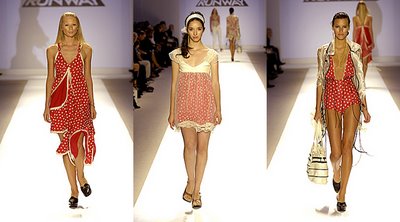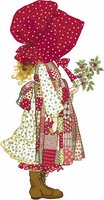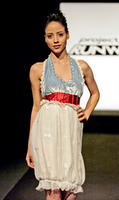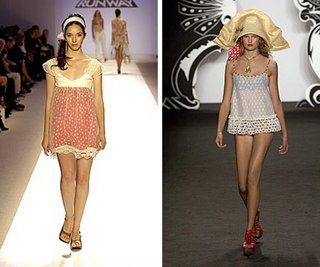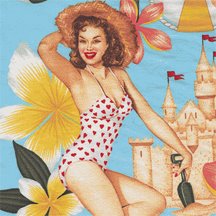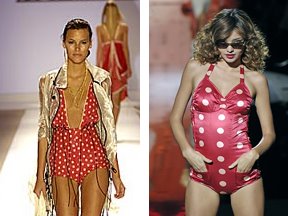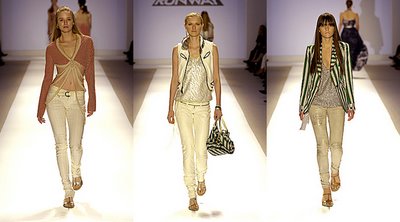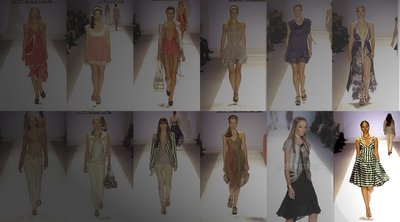(click here to go to the first part of "what jeffrey has to show for himself")
THE THEME
his muse, his self
In looking closely at his work I think that what distinguishes Jeffrey from the other three finalists is his lack of attention to women's bodies. He's interested in doing something else. I think this is why he wanted to have the models all wear matching wigs. For many designers the models become their muses but Jeffrey's muse is himself and his ideas.
marilinda la maravillosa
Now I'm not saying that he wasn't fond of Marilinda. He better be. He would not have made it to the final four without her because she saved his ass a couple of times. She sold that couture gown like she was the Calypso Queen at Carnivale.
 (I don't know where she is from originally and I am pretty sure she isn't from Trinidad but the way she sashayed down the runway reminded me a of a dance from there.)
(I don't know where she is from originally and I am pretty sure she isn't from Trinidad but the way she sashayed down the runway reminded me a of a dance from there.)Marilinda could sell the Emperor's new clothes (and some would say that she did).
 On the other hand, there are some things that would make the Queen of England look like a whore.
On the other hand, there are some things that would make the Queen of England look like a whore.When it came to lapses in taste all of Kayne's glitter and rhinestones could not top what Jeffrey could barf up on the runway.
Anyway, I am certain that Jeffrey appreciated and liked Marilinda but I never get the sense that she -- or any woman -- was his muse.
Except perhaps Gwen Stefani, which may be why he wanted to have the blond wigs because that is exactly what Stefani did in her L.A.M.B. collection show this fall:
 And by the way -- nothing says "Japanese ghost and demon stories" like a runway full of models in blond wigs.
And by the way -- nothing says "Japanese ghost and demon stories" like a runway full of models in blond wigs.japanese ghost and demon stories
Okay, I have to talk about this one.
How many times did we hear Jeffrey tell people that his collection was inspired by "Japanese ghost and demon stories"? He said it enough times that one would assume that this was important to what he was doing. Everytime he said it Tim Gunn or Michael Kors or Nina Garcia or whomever would nod their head and be very impressed with his intellectual depth and creative breadth.
I just want to know why no one said, "Gee, that sounds interesting, Jeffrey. It sounds like you have some great tattoo design books around your house. And little Harrison must enjoy the stories about the demons that eat children. However, in what way do your clothes have ANYTHING ON GOD'S GREEN EARTH to do with Japanese ghost and demon stories?"

Right to Left: 1. Ôya Tarô Mitsukuni from the series One Hundred (Ghost) Stories from China and Japan 1865 by Tsukioka Yoshitoshi (1839-1892); 2. Image of a Yama-chichi (1841) by Takehara Shunsen (1762-ca.1830); 3. to be provided.
It is fine if he started there and ended up somewhere completely different. That happens a lot in the creative process.
However, if the final collection has little to do with Japanese ghost and demon stories then why did he keep bringing it up? Why? Because it sounded good. And it didn't just sound good. It sounded cool. Kora knows bullshit when she hears it.
I think it is safe to say that generally speaking, the images for the various collections of stories -- the most famous being One Hundred Tales by Katsushika Hokusai (1760-1849) --

Left to Right: 1. The Plate Mansion (Sara-yashiki); 2. Skeletal Ghost (Kohada Koheiji); 3. The Laughing Hannya (Warai-hannya); 4. Oiwa (Oiwa-san). All of the above images are from One Hundred Tales by Katsushika Hokusai (1760-1849). Additional references and links are at the bottom of the post.do not use the color palette Jeffrey used. That is, the primary colors of 40s pinup retro-red polka dots and circus green and white stripes are not what one thinks of when imagining something inspired by Japanese folk culture.
I'd also like to point out that it isn't like high fashion doesn't have a lot of brilliant examples of designers who have been inspired by various aspects of Japanese culture and aesthetics, including peasant culure. Issey Miyake, Rei Kawakubo and Yohji Yamamoto are just the three most famous designers to emerge from Japan since the seventies. And, of course, Japan is the most lively place for street fashion that is centered around the teen age girl.
One could say that Jeffrey's Holly Hobby apron dress (see previous post) and the Marilinda dress "gesture" towards some of the folding and pleating that is associated with Japanese high fashion design today.
 Left: Japanese- style wedding gown by Monique Bridal Couture Collection
Left: Japanese- style wedding gown by Monique Bridal Couture CollectionRight: Ball gown style wedding gown by Mori Lee
Although, I would consider the gesture to be a bit too broad to really indicate something specifically Japanese. Is Jeffrey's dress more "Japanese" than "ball gown" in its styling? (The great thing about using wedding gowns as examples is that in a pinch they are basic examples of generic types for dresses.)
I'm just not seeing is what this has to do with Japanese ghost and demon stories. However, I certainly have not read every ghost story or seen every ukiyo-e print of ghosts and demons. I am also quite willing to believe that there is something in the collection that is obvious to most people that I'm just not seeing.
If there is, so far no one I've read has explained it to me. Sure, people have mentioned something vague like "seeing a Japanese influence." But this doesn't really support the specific reference to Japanese ghost and demon stories.
Here's the thing. The book below is about Japanese ghosts and demons and is popular among tattoo artists. It has some bright red and green on the cover and perhaps the prints inside are also richly printed. The actual ukiyo-e prints are not as saturated and are often very faded (if not damaged). My best guess is that this might be the kind of book he was looking at.

I know it's a stretch but I'm grasping at straws here, trying to give Jeffrey the old Project Runway benefit of the doubt. But I still don't understand the whole reference to demons and ghosts. I don't really see much of an element of fantasy in his collection. It seems like the three other designers have a greater sense of that than he does (but more on that later).
As I was looking at some of the ukiyo-e prints I wondered whether he was inspired by the images of ghosts and demons or was it more by the style of the prints themselves? That is, are his clothes more connected to the Hokusai demon images (above) rather than, say, Hokusai's images of street life? Or just the fabrics and designs of the clothes in the prints? Or the graphic lines of the woodblock prints? (After all, a great deal of late nineteenth and early twentieth century art can be traced back to the influence of these prints on western artists.)
For example, do his clothes have a connection to the woman on the right (below), because she is a ghost that they don't have with the woman on the left even though the woman on the left is wearing a garment that has more similarities to the clothes he designed? (I'm speaking in broad terms such as the stripes and hanging folds.)
 Left: "Woman in River Scene" c. 1848 by Utagawa Kunisada (1786-1864)
Left: "Woman in River Scene" c. 1848 by Utagawa Kunisada (1786-1864)Right: "The Ghost of Okiku at the Dish Mansion" by Tsukioka Yoshitoshi (1839-92)
And if he was so taken with these tales then which ones in particular? His collection can't be about the hundreds of stories, he must have had to pick out a few, perhaps even just one?
There is the popular tale of the maid Okiku who breaks her master's Delft plates for which she is killed by being thrown into a well that she haunts and poisons (the Hokusai image above on the far left). One of my favorites is the tale of Oiwa, the dead wife who haunts the husband who disfigured her, taking on various forms including that of a paper lantern (the Hokusai image above on the far right).
I don't get any sense that the narratives have anything to do with his collection. Frankly I wouldn't be surprised if he never read any of the tales. That is fine except for the fact that he made it sound like there was a literary context for his collection.
It seems like he got a lot more credit than perhaps he deserved for the narrative context of his collection. He certainly had a better story than the others. The judges were all much more impressed with his. But the others didn't pretend to be anything more than what they were. I have a lot more respect for that. Especially when you consider how amazing they really are. They didn't need to pretend to be more.
If there is any connection at all it is probably going to be at the visual level and not the narrative level because I don't see how the clothes tell much of a story about Japanese ghosts and demons. There were no decapitations or snakes or goblins that I could see. Unless you count this:
 (I'm just joking, I don't expect it to be that literal of course.)
(I'm just joking, I don't expect it to be that literal of course.)If Jeffrey could have pulled this off I would be the first to be wowed and delighted by his collection. Believe me I would love to see such a collection that created a contemporary fashion statement out of an art form that has such intense visual and literary power. But in terms of what Jeffrey produced: sorry, I'm not buying it. Literally and figuratively.
But if anyone has any thoughts how these twelve pieces might, say, serve the fashion needs of a Japanese demon woman -- taking her through her day, please feel free to share them.
That said, this really IS fascinating material: both the Japanese art of ukiyo-e and its folk culture's myths and legends. So if you are interested in finding out more here a couple places online to start investigating:
- Library of Congress Online Exhibit on the Floating World of Ukiyo-E
- Ghosts, Demons and Spirits in Japanese Lore a short article
- Viewing Japanese Prints a great resource on Japanese woodblock prints
- Ukiyo-E in the Sweet Briar College Collection Representations of Women
- A few recommended readings, from the relevant to the random






